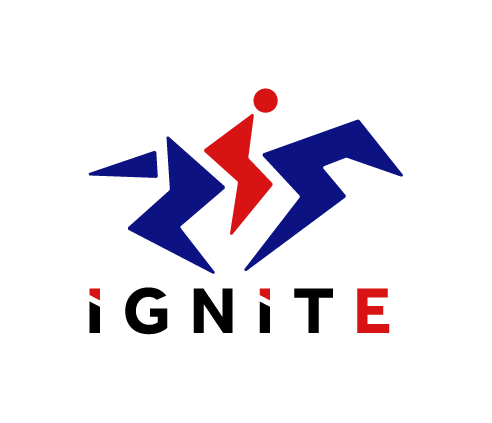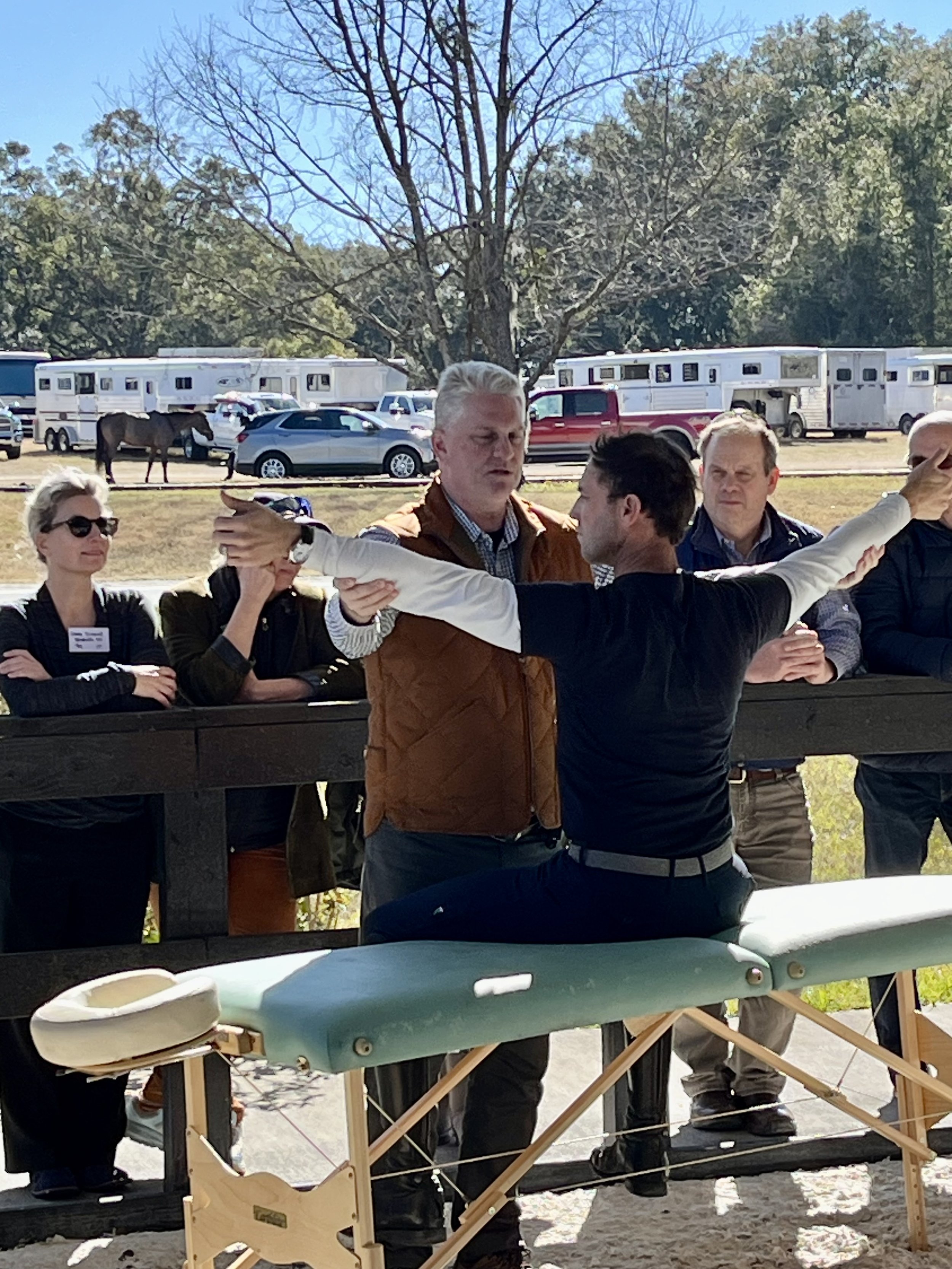2nd Annual Sport Science Seminar Unites and IGNITEs Equine Industry
by Kim F Miller
“Mind-blowing” was a go-to reaction for attendees describing their experience at IGNITE’s 2nd Annual Sport Science for the Olympic Disciplines Seminar.
Dedicated to advancing equine athlete management, the Seminar drew a diverse field of experts to the World Equestrian Center in Ocala, FL on Jan. 12-13. These veterinarians, physios and researchers connected with top riders, grooms, farriers, footing experts, coaches and owners to compare experiences, ask questions and discuss forward paths for ensuring sport horse well-being, longevity and performance.
Lateral thinking, outside-the-box thinking and collaboration were emphasized in developing a progressive culture for teams supporting sport horses.
Presentations ranged from the very specific – like an encouraging study on the potential for orthobiologics in treating equine asthma – to the broad, like Sunday’s no-holds-barred discussion of the future of equestrian sports as social licensing issues intensify along with concerns about equestrian’s place in the Olympics.
Many discussions were enhanced with wet lab-style workshops at the University of Florida Veterinary Hospital at WEC.
“It was mind-blowing,” said long-time international eventing groom Max Corcoran. “There was so much information, so many smart people who are so passionate about everything they do – whether it’s artificial intelligence, understanding gait analysis, lung capacity, farriery, physiotherapy… Bringing all these people together in one place so we can learn from them is amazing.
“Even though we’re just getting a tiny piece of what they can offer us, it’s all things we can put together to make our horses better, more competitive and extend their careers.”
Lateral Thinking
Beau Whitaker, DVM, shares results of a study on using shockwave therapy to treat equine asthma.
One of IGNITE’s founders, Mark Revenaugh, DVM, welcomed attendees with an invitation to embrace and apply “lateral thinking” to sport horse management.
Along with fellow international vet, Tim Ober, Revenaugh founded the group as the Equine High-Performance Sports Group over 10 years ago. “Our first motive was how can we get better outcomes?” he said. “As time passed, we got involved with human sports practitioners and realized that their priorities were around keeping athletes happy and healthy and knowing that would lead to better outcomes. That helped us converge into dual priorities of getting better outcomes and improving the well-being of the horse.
“IGNITE is embracing new and creative ways to improve our horse’s well-being with emphasis on maximizing performance and longevity,” Revenaugh continued. “It is time for the veterinary profession to embrace modern methodologies, as is done in human sport science, and add them to the toolbox for managing our equine athletes.”
An increasingly diverse membership inspired a rebranding of the group to IGNITE in January of 2024. Late last year, IGNITE transitioned to a non-profit status as a “platform to facilitate open-ended improvement in the equine industry,” he explained.
Tech & Data
Cris Navas de Solis sharing cases of heart rate and lactate monitoring in eventing horse training programs. PC: Hilltop Bio/OnTheMarkMedia
The human performance world is far ahead of equine sports in the collection and use of biometric data in training programs and management decisions. But equine veterinarians including Seminar presenter Cris Navas de Solis DVM, University of Pennsylvania, are leading a sea change in horse sports.
Heart rate, heart rate recovery and lactate testing are among the metrics helping horses improve their performance, prevent injuries and – sometimes -- get redirected to a discipline better suited to their physiology.
Lactate testing can be a game-changer for high performance horses, Navas de Solis explained. Muscles produce lactate when they’ve used up fat stores for energy. When they switch to drawing on glucose as their energy source, lactate is produced.
Measuring when a horse starts producing lactate during a work-out of specific intensity and duration is a constructive tool.
Navas de Solis shared the example of one of Tamie Smith’s top horses. The Team USA eventer knew she had a great horse in Danito but had struggled to make the time on cross-country. Combining lactate and heart rate testing with Navas de Solis’ help, Smith altered the horse’s conditioning program to include more sprint work going into the Maryland 5* in 2022.
“Prior to that he had never made the time, and that year he was 20 seconds under, even though we had otherwise done the same training,” Smith shared. The pair finished 2nd at Maryland and Smith became one of several leading event riders to add biometric data to her horses’ program.
Team USA eventer Tamie Smith sharing her experiences adding biometrics into her horses’ prep programs.
There’s an injury prevention benefit to Smith’s realization. “If you look at a horsemanship book, you’d think what we were doing was getting our horses fit. But for these types of horses, you are almost doing too much, which could lead to more injury risk.” Working smarter, not harder, is the goal. The dangers of over-training are widely recognized in the human athlete world and becoming so in sport horse management.
In creating a fitness plan, data enables the horse’s team to “make a bigger first floor foundation or raise the ceiling,” Navas de Solis stated. “It guides how we plan for the long run. We know where we are, we determine where we want to be, and we make a plan for getting there.” Expect frequent revisions, he added.
Context Over Content
“The numbers on their own mean nothing,” he cautioned. “They need to be filtered through brains that understand the context. Context is more important than content.”
Swedish veterinarian and researcher Elin Hernlund had similar cautions in her presentations on the use of gait analysis tools made possible by evolving artificial intelligence and machine learning.
A pioneer with the Sleip gait analysis system, Hernlund clarified the important difference between asymmetries in loading patterns and lameness. She referenced a study in which “one-third of high performing horses had gait asymmetry values of similar magnitude to those seen in clinically lame horses.”
In picking up over 150 key anatomical points on a horse moving to, away from or across the camera’s view, the Sleip system is proving most useful as a means of detecting gait patterns and changes flagging potential lameness.
Will Coleman riding as Elin Hernlund compares visual observations to those provided by the Sleip gait analysis system.
A demonstration with another Team USA eventer, Will Coleman, showed how the rider can influence the horse. In Coleman’s case, it was for the good as his aids helped an 8-year-old Irish Sport Horse push off stronger on its weak side than it had when trotting in-hand.
Gait analysis is rapidly gaining traction with team vets and top riders, Hernlund shared. German dressage team veterinarian Marc Koene uses it to monitor horses when he’s not physically with them. Austrian show jumper Max Kuhner uses it to pick up problems earlier. Swedish show jumper Peder Fredricson records his horses every other week to identify patterns and slight changes and to compare results to what he’s sensing from the ground and the saddle.
Objective data also enhances communication between everyone caring for a horse. “It can reduce tension between the vet, the rider and the groom because it’s data,” Hernlund stressed. “It facilitates an important and interesting way of evolving communication that has the horse in the center of the discussion.”
During the same demonstration on horse-rider interaction, physiotherapists Kirk Peck and Emily Rose discussed how the horse and rider’s biomechanics affect each other. In Coleman’s case, he could improve the balance in his horse’s trot, while a less talented and/or less balanced rider could do the opposite.
Both physios work on people and animals. They greatly prefer to observe the rider and the horse working together, then do hands-on observations and treatments of each.
They stressed that riders must consider and manage themselves as athletes, with the same attention to joint mobility, strength and flexibility they know is critical for their horses.
Peck and Rose noted that human athletes are gradually embracing physical therapy for injury prevention and performance enhancement. It’s the case even though insurance companies typically only cover physical therapy for rehab from an injury.
Physical therapist Kirk Peck and Team USA rider Will Coleman
They encouraged attendees to embrace this “pre-hab” approach in their horse’s management. Pre-habbing also sets a horse up for a more successful rehab if they do get injured.
More Data & Sharing
“More data” was called for in almost every session over two days.
IGNITE’s Equine Clinicians Registry was described as a step toward fulfilling that challenging request. Starting in 2022, the Registry began to “acquire and analyze clinical data to gain deeper insights into outcomes for equine athletes being treated with orthobiologics,” Dr. Revenaugh explained.
It’s early days, he emphasized, including a steep learning curve for the realities of collecting and using the information. “This is a foundation in the horse world to start building info to help inform all of us what is the right thing to do next.”
Attendees applauded the Registry and recognized the need for further support within the industry. “This is a long-term project we can all get behind,” Revenaugh said. “We already have some wonderful support from diverse interests within the industry, but it can’t happen without further and ongoing financial support.”
Technology can help gather data, but the process also requires a shift toward sharing information.
“We’re going to have to take the lid off some things that we sometimes want to keep close to the vest,” said Chris Kawcak, DVM, of Colorado State University. That’s in addition to valuing data from those closest to the horse. “Sometimes the groom has the best feedback of anybody.”
Ali Morton, DVM, Medical Director of the U of Florida Veterinary Hospital, echoed the call for transparency. “We as an industry have to become more transparent and that is really difficult. There’s a nature to not reveal what’s wrong with our horses.
“What IGNITE is doing is brilliant. We all need to jump aboard and get on the bus!”
Too Much Good Stuff!
The summaries above barely scratch the surface of the 11 sessions held over two days in Ocala, plus the afternoon of demos at the U of Florida Veterinary Hospital. Deep dives into respiratory health, progressive shoeing, bone remodeling, heat stress and building a team around an athlete were among many topics spurring engagement, inquiries and lively discussion.
IGNITE members have access to all the Seminar’s sessions online, along with 180+ hours of presentations on a wide range of topics related to sport horse health, performance and longevity.
Join IGNITE here.
Subscribe to IGNITE’s newsletter and follow IGNITE on Facebook, Instagram and LinkedIn to stay abreast of additions to our online library and upcoming events.
IGNITE thanks Foundation Partner Hilltop Bio for its ongoing support, and thanks the following sponsors of the 2nd Annual Sport Science for the Olympic Disciplines Seminar:
Hilltop Bio, Astaria Global, PulseVet/Zomedica, ArthramidVet, Dechra Equine, Sleip, Bartek Equine, Northwest Equine Performance, Platinum Performance, Soft Ride, the Poggio Horsemanship Fund, the University of Florida Veterinary Hospital, RevitaVet, Steele & Associates, Sure Foot Pads, ArenaMend, Ice Horse and Yeti.
To discuss IGNITE sponsorship, please contact Joop@IgniteforEquineAthletes.com.





